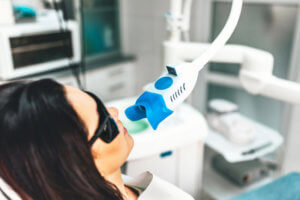Laser dentistry is a form of therapy that became available in the mid-1900s, and it involves the use of lasers to help treat a myriad of different dental conditions. It presents a more comfortable treatment option for several dental procedures, especially when compared to drills.
However, despite gaining approval from the FDA, no laser system has yet gained the American Dental Association’s (ADA) Seal of Approval as an alternative treatment to the traditional methods.
The above-mentioned seal assures dentists that the product or device meets the standards of the ADA when it comes to safety and efficacy, among others. However, the ADA states that it’s cautiously optimistic about the role of laser technology in the field of dentistry. These lasers are a bit different from the cold lasers used for other treatments.
Still, dentists may use lasers to help treat the following:
- Tooth Decay: Lasers are used to help remove any decay found in a tooth, thus helping to prepare the surrounding enamel to receive the filling.
- Gum Disease: Lasers are used in reshaping the gums, as well as helping to eliminate bacteria during root canal procedures.
- Teeth Whitening: Lasers are also used to hasten teeth whitening procedures. A peroxide bleaching solution, applied to the surface of the tooth, is “activated” by the energy emitted by the laser, which then helps speed up the whitening process.
How Are Laser Treatments Performed?
There are two main kinds of procedures that are used for laser dentistry — hard and soft tissue procedures. Hard tissue refers to the teeth, and the soft refers to the gums.

The common hard tissue procedures include:
- Cavity Detection: Lasers can detect cavities early by scouting for tooth decay
- Tooth Preparation: Local anesthesia and traditional drills are sometimes not needed when it comes to laser treatments. That’s’ because the laser itself can kill the bacteria in a cavity, which aids in the long-term health of a tooth.
The common soft tissue procedures include:
- Crown Lengthening: This procedure helps reshape both the gum tissue and bone for a healthier tooth structure, which helps with placing restorations on the teeth.
- Treating a “Gummy Smile”: Lasers are used by dentists to help reshape the gum tissue linked with a “gummy smile,” in which the gum’s length covers most of the tooth.
The Pros and Cons
Compared to the traditional dental drills, lasers are known to:
- Cause less pain in some circumstances, thus lowering the need for anesthesia
- Lower anxiety in patients who are normally uncomfortable with the use of a dental drill
- Reduce bleeding and swelling that can occur during soft tissue treatments
However, there are a couple of disadvantages to also consider, and they are:
- Lasers can’t be used if there are fillings already
- Traditional dental drills may still be needed to shape the filling, adjust the bite and polish fillings – even when a laser has already been used
- Lasers don’t eliminate the need for anesthesia completely
If you plan to try out a laser dental treatment, you can talk to your holistic dentist for more information. They’ll be happy to give you more information about this form of dental treatment.





